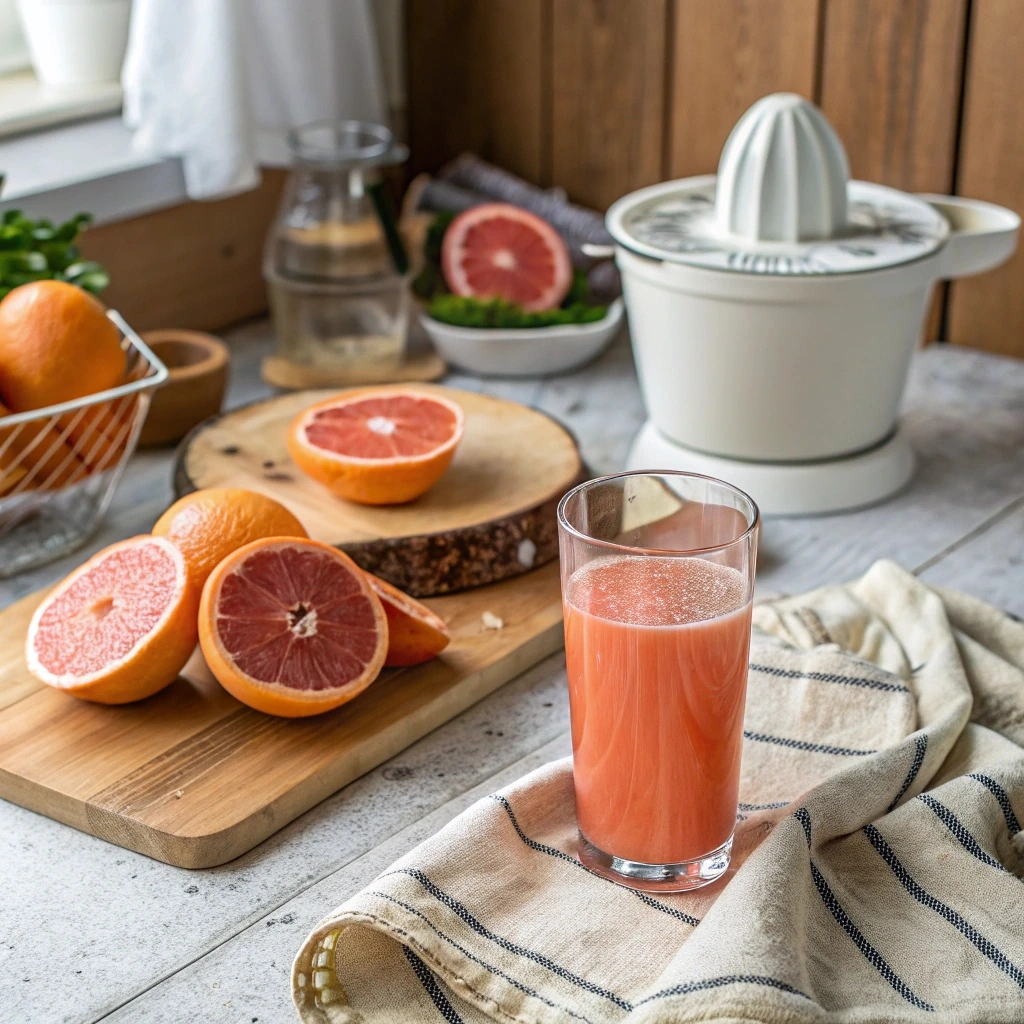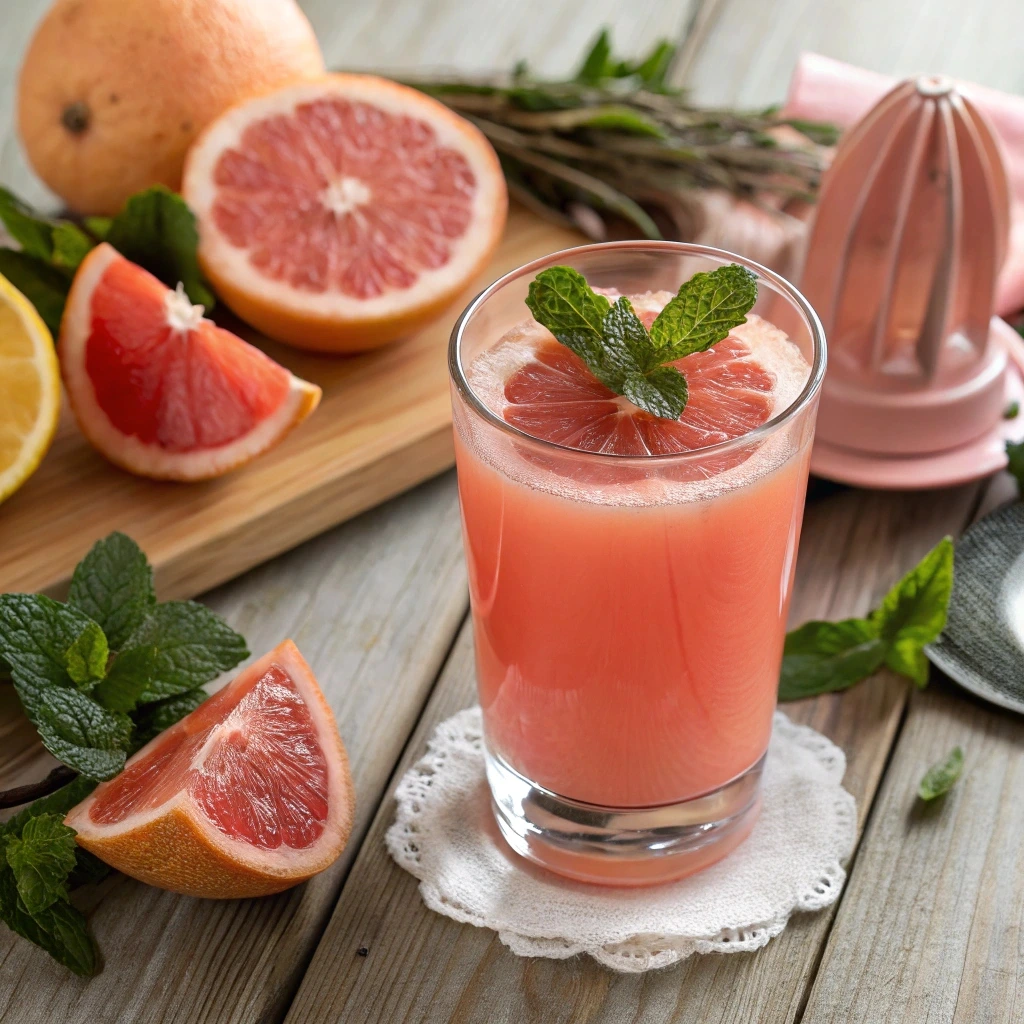Craving something tart, tangy, and totally refreshing? Homemade grapefruit juice might just become your new favorite. Not only does it pack a citrusy punch, but it’s also bursting with nutrients that can support weight loss, boost your immune system, and improve your skin from the inside out.
This comprehensive guide walks you through everything you need to know—from health benefits and recipe ideas to juicing techniques and storage hacks. Whether you’re into pure juice, mix-ins like ginger or honey, or even a cheeky grapefruit cocktail, we’ve got you covered.
So, let’s dive headfirst into the juicy details, starting with what homemade grapefruit juice is all about and why it’s quickly squeezing its way into health-conscious kitchens everywhere.
Table of Contents
Introduction to Homemade Grapefruit Juice
What Is Homemade Grapefruit Juice?
At its core, homemade grapefruit juice is exactly what it sounds like—freshly squeezed juice made right in your own kitchen using ripe grapefruits. No artificial flavors, no added sugar, and definitely no preservatives. It’s the kind of clean, zesty drink that tastes like sunshine in a glass. Compared to store-bought options, which often sneak in sweeteners or preservatives, this DIY version is as natural as it gets.
All you really need is a few fresh grapefruits, a knife, and a little elbow grease (or a juicer if you prefer the easy route). Some folks like to jazz it up with ingredients like lemon juice, mint, or even cucumber for added benefits and flavor variety.
Why It’s Gaining Popularity Among Health Enthusiasts
Why are more people turning to homemade grapefruit juice lately? Well, for starters, it’s packed with vitamin C, fiber, antioxidants, and a host of other goodies that help with everything from weight loss to immune support. Plus, it’s versatile. You can blend it into smoothies, add it to detox waters, or just enjoy it straight-up over ice.
Moreover, people love knowing exactly what’s in their drinks. Making juice at home puts you in control—of the ingredients, the sugar level, and even the pulp (some love it, some don’t). It also aligns perfectly with plant-based and low-calorie diets, making it a favorite among wellness circles.
In addition, grapefruit juice recipes often tie into beauty and fitness goals, making them a top pick for those on the journey to better health. As more folks lean toward holistic and natural living, this vibrant juice is getting the spotlight it deserves.
Nutritional Profile of Grapefruit Juice

Key Vitamins and Minerals in Grapefruit Juice
Homemade grapefruit juice isn’t just delicious—it’s loaded with powerful nutrients that can do wonders for your health. For starters, it’s an excellent source of vitamin C, which plays a key role in supporting your immune system and repairing body tissues.
But that’s not all. This juice also contains vitamin A, essential for eye health, and a good dose of potassium, which helps regulate blood pressure. Moreover, it includes antioxidants like lycopene and beta-carotene that help fight inflammation and oxidative stress.
In addition, the juice offers small amounts of magnesium, thiamine, and folate—all contributing to better metabolic function and heart health. So, even in just one glass, you’re getting a nutrient-dense beverage that supports your entire body.
Calories, Carbs, and Fiber: What You Need to Know
Now let’s talk numbers. A 100 ml serving of fresh grapefruit juice has about 39 calories, making it a great low-calorie option compared to sugary store-bought drinks. It contains approximately 9g of carbs, but most of these are natural sugars paired with beneficial fiber.
Here’s the good part—if you blend rather than strain your juice, you retain more fiber, which supports digestion and helps you feel full longer. Therefore, homemade grapefruit juice becomes an easy, guilt-free choice for those on weight-loss or low-carb diets.
For people watching their blood sugar, grapefruit’s natural sugars digest more slowly thanks to its fiber and antioxidants, so it doesn’t cause spikes like refined juices. However, it’s still smart to enjoy it in moderation if you’re managing diabetes.
Health Benefits of Homemade Grapefruit Juice
Weight Loss Support and Metabolic Boosting Effects
If shedding pounds is part of your wellness plan, then homemade grapefruit juice might become your new secret weapon. Thanks to compounds like naringin and nootkatone, grapefruit can help burn fat more efficiently by boosting your metabolism.
In addition, its low calorie count and high fiber content make it perfect for reducing hunger between meals. Drinking a glass 30 minutes before eating may help curb your appetite, leading to smaller portions and fewer cravings.
Pro Tip: Add a pinch of chili powder to the juice. Why? Because capsaicin, found in chili, also promotes fat burning and thermogenesis. That’s two natural metabolism boosters in one glass!
Skin Health and Anti-Aging Properties
You might be surprised to learn that homemade grapefruit juice also has skin-loving benefits. It’s full of vitamin A, vitamin C, and antioxidants that help protect skin cells from aging and environmental damage.
For example, vitamin C supports collagen production, which helps keep skin firm and youthful. On top of that, its anti-inflammatory properties can soothe skin conditions like acne or redness.
Moreover, by improving digestion and detoxing the liver, this juice indirectly supports clearer skin from within. A healthy gut often leads to glowing skin!
Immune System Reinforcement Through Vitamin C and Antioxidants
Let’s not forget immunity. When cold and flu season hits, a daily dose of homemade grapefruit juice can help keep your defenses up. High levels of vitamin C strengthen your immune response, while zinc and iron help white blood cells do their job.
Also, combining grapefruit with ginger, lemon, or honey enhances these effects, giving you a naturally sweet immunity elixir. Therefore, this citrus powerhouse isn’t just tasty—it’s a true health ally.
Sample Immune-Boosting Juice Recipe
Here’s a quick and easy recipe packed with immune-supportive ingredients:
| Ingredient | Quantity |
|---|---|
| Pink grapefruit | 2 medium |
| Fresh ginger (peeled) | 1 tsp |
| Lemon juice | 1 tbsp |
| Raw honey | 1 tsp (optional) |
| Cold water | 1/2 cup (optional) |
Simply blend everything together and strain if desired. You’ll have a refreshing, zingy drink that’s as good for your body as it is for your taste buds.
How to Make Homemade Grapefruit Juice
Basic Recipe: Classic Fresh-Squeezed Grapefruit Juice
Making homemade grapefruit juice is super simple—and incredibly rewarding. You’ll need just a few ingredients and a few minutes of your time. The result? A refreshing, tangy drink that’s loaded with nutrients and way better than anything you’ll find on a grocery shelf.
Here’s a basic version to get you started:
| Ingredient | Quantity |
|---|---|
| Pink or red grapefruit | 2 large (juicy) |
| Cold water | 1/2 cup (optional) |
| Raw honey or agave | 1 tsp (optional) |
| Fresh mint (for garnish) | 2–3 leaves |
Steps:
- Cut the grapefruit in half.
- Use a hand juicer or citrus press to extract the juice.
- Strain through a fine mesh if you prefer it pulp-free.
- Stir in water and honey if needed.
- Serve over ice with mint for flair.
And that’s it—so simple, yet so satisfying!
Juicing Techniques: Blender vs. Hand-Squeezed vs. Juicer
Now, let’s talk technique. You’ve got options depending on your tools and taste.
- Hand-Squeezed: Ideal for purists. Squeeze directly into a glass for an authentic, rustic feel.
- Blender Method: Add peeled grapefruit chunks with a splash of water. Blend and strain if you want it smooth. This way, you keep more fiber intact.
- Juicer Method: Fast and clean. Electric juicers save time and make large batches easier.
Each method has pros and cons, but all deliver that classic grapefruit juice detox experience. Moreover, if you’re into juice cleanses, this is a staple.
👉 For more delicious detox ideas, don’t miss our Best Juicing Recipes for Weight Loss.

Creative Variations of Grapefruit Juice Recipes
Grapefruit + Orange + Lemon: Triple Citrus Zing
When life gives you citrus—make a zingy trio. Mixing grapefruit with orange and lemon balances tartness with a sweet and sour pop. It’s sunshine in a glass.
| Ingredient | Quantity |
|---|---|
| Grapefruit | 1 large |
| Orange | 1 medium |
| Lemon juice | 1 tbsp |
| Cold water | 1/2 cup (optional) |
Blend or squeeze and enjoy cold. This one’s a fan favorite for vitamin C lovers.
Grapefruit + Apple + Carrot: Sweet and Nutritious Combo
Want something more rounded and earthy? This trio gives you antioxidants, beta-carotene, and a naturally sweet finish.
| Ingredient | Quantity |
|---|---|
| Grapefruit | 1 large |
| Apple (green/red) | 1 medium |
| Carrot | 1 medium |
| Ginger (optional) | 1 tsp grated |
This juice also supports skin health and digestion. Plus, kids love the taste.
Cucumber + Grapefruit: Detox and Hydration Mix
For those extra hot days or post-workout refreshment, this combo hydrates while offering a cooling, spa-like vibe.
| Ingredient | Quantity |
|---|---|
| Grapefruit | 1 large |
| Cucumber | 1 small (peeled) |
| Lime juice (optional) | 1 tbsp |
It’s a refreshing twist that supports kidney health and hydration.
Vodka or Tequila + Grapefruit: Cocktail Options (Optional Add-on)
Feeling festive? Add a grown-up spin to your homemade grapefruit juice. Known as Paloma when paired with tequila or Greyhound with vodka, these cocktails are perfect for brunch or backyard BBQs.
Note: Always drink responsibly and use fresh juice for the best flavor.
For more bright, fruity beverage ideas, you might enjoy our fresh orange juice benefits and recipes, which complement grapefruit drinks perfectly.
Homemade Grapefruit Juice for Specific Health Goals
For Weight Loss: Add Fiber, Chili, or ACV
Trying to shed a few pounds? You’re not alone—and homemade grapefruit juice can lend a hand. When made with pulp, it naturally contains fiber, which helps keep you full and slows digestion. That means fewer cravings and better portion control throughout the day.
But wait, there’s more. Adding a dash of chili powder or cayenne can crank things up a notch. Why? Because chili contains capsaicin, a compound known to boost fat burning and curb appetite. Blend it right into your juice for a fiery, metabolism-kicking twist.
Another trick is to mix in apple cider vinegar (ACV). Just a teaspoon will do the trick. It helps balance blood sugar and may support fat loss over time. However, be sure not to overdo it, as ACV is acidic and should be used sparingly.
For Skin Health: Combine with Beetroot, Carrot, and Turmeric
If glowing skin is on your wish list, look no further. Grapefruit is rich in vitamin C, which boosts collagen production and fights free radicals. But by mixing your juice with beetroot, carrot, or a pinch of turmeric, you’ll unlock even more beauty benefits.
Carrots are full of beta-carotene, which helps repair skin and gives it a natural glow. Beetroot supports blood flow and detoxification, which also contributes to a clearer complexion. And turmeric? It’s a powerful anti-inflammatory that works wonders from the inside out.
Simply toss the ingredients into a blender with your grapefruit, strain (or don’t), and enjoy. Your skin will thank you!

When and How Much to Drink Grapefruit Juice
Optimal Times: Before Meals or After Exercise
Timing can make all the difference when it comes to getting the most out of your homemade grapefruit juice. For example, drinking it 30 minutes before a meal may help reduce appetite and lower post-meal blood sugar levels. This is especially helpful if you’re watching your weight or managing insulin sensitivity.
Moreover, it’s a smart choice after a workout, since grapefruit juice is hydrating and replenishes lost electrolytes—without the added sugars found in sports drinks. The natural carbs help restore energy, while the vitamin C supports muscle repair.
On those sluggish mornings? A glass of fresh juice can replace your usual cup of coffee thanks to its energizing effect and high water content.
Serving Size Recommendations for Adults and Kids
So how much should you drink? Generally, one 8-ounce glass per day is plenty. That’s enough to soak up the health benefits without overloading on natural sugars. For children, aim for 4–6 ounces, depending on age and activity level.
While homemade grapefruit juice is undoubtedly nutritious, moderation is key. For instance, too much citrus can be hard on your teeth and stomach. Therefore, if you’re sensitive to acidity, use a straw and rinse your mouth afterward.
Finally, be mindful of interactions with certain medications. If you’re unsure, it’s always best to check with your doctor before making grapefruit juice a daily habit.
Who Should Avoid Grapefruit Juice
Medications That Interact with Grapefruit Juice
While homemade grapefruit juice offers many health perks, it’s not for everyone. One major reason? It can interfere with how certain medications work. Grapefruit contains compounds that block an enzyme in your intestines responsible for breaking down many prescription drugs.
As a result, this can lead to higher levels of medication in your bloodstream, increasing the risk of side effects. Common medications affected include:
- Blood pressure meds
- Cholesterol-lowering statins
- Anti-anxiety drugs
- Certain antihistamines
- Immunosuppressants
If you’re on any of these, it’s best to skip the grapefruit juice—or check with your doctor first.
People with Gastric Issues or Sensitive Teeth
In addition, those with acid reflux, ulcers, or gastritis may find that citrus juices irritate their stomach lining. Because grapefruit is naturally acidic, it can worsen heartburn or discomfort.
Similarly, the acid in homemade grapefruit juice may erode enamel over time, especially if you sip it daily. Therefore, consider using a straw to protect your teeth and rinsing your mouth afterward.
Storage and Shelf Life of Fresh Grapefruit Juice
How to Store Homemade Juice Safely
Since homemade grapefruit juice doesn’t contain preservatives, it’s important to store it properly to keep it fresh. Always use a clean, airtight glass jar or bottle and refrigerate the juice within 30 minutes of making it.
For best results, store it in the coldest part of your fridge, not in the door where temperatures fluctuate. This helps preserve both the flavor and nutrients.
How Long It Lasts in the Fridge
Typically, fresh juice lasts up to 3 days in the fridge. However, the sooner you drink it, the better it tastes—and the more nutrients you retain.
If you made a big batch and don’t want it to go to waste, you can also freeze it in ice cube trays. Then, pop out a few cubes and let them melt for a quick boost later.
Just remember, freezing may dull the flavor slightly—but it’s still better than tossing it!

Frequently Asked Questions (FAQs)
When Should I Drink Grapefruit Juice for Weight Loss?
The best time to drink homemade grapefruit juice for weight loss is about 20–30 minutes before a meal. This timing may help reduce appetite and prevent overeating. Additionally, it helps balance blood sugar levels after meals, which is great for those managing insulin.
Can I Drink It on an Empty Stomach?
Yes, but it depends on your stomach’s sensitivity. Some people love starting their day with a glass of citrusy juice, but others may find the acidity too harsh. If you’re prone to heartburn, consider drinking it with a light snack instead.
Is It Safe for People with Diabetes?
It can be, as long as it’s unsweetened. Homemade grapefruit juice made without added sugar has a lower glycemic load than commercial juices. However, portion control is key—stick to half a glass to one glass daily, and monitor your blood sugar if you’re unsure.
What Are the Side Effects of Too Much Grapefruit Juice?
Drinking too much can cause digestive upset, especially in people sensitive to acidity. It may also lead to enamel erosion or interact with medications. As always, moderation matters.
If you’re new to citrus juicing, start small and pay attention to how your body responds.

